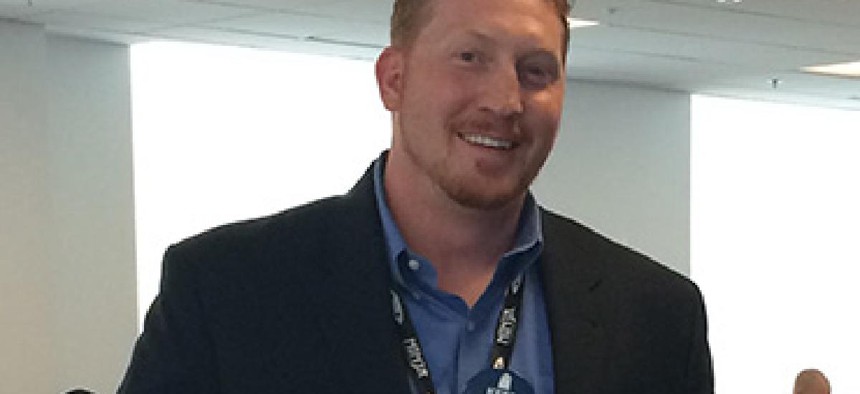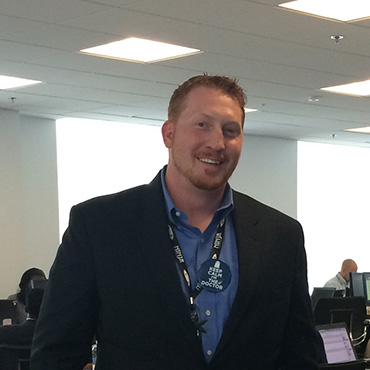At CIS, they DID(IT)

James Tunnessen has instilled a sense of urgency in the IT team as head of digital innovation and development at Citizenship and Immigration Services.

Citizenship and Immigration Services' James Tunnessen, shown here at the agency's Oct. 21-23 hackathon.
Eighteen months ago, the technology office at DHS's Citizenship and Immigration Services wasn't using open source technology, web responsive design or a mobile-first approach, and applications or new IT solutions typically took months to roll out.
Not anymore.
When James Tunnessen came to CIS a year and a half ago from the General Services Administration, he walked into an office that needed work. CIS offices are spread across the country, and so was IT development. People in different locations were building the same thing twice, and Tunnessen, head of digital innovation and development at the Homeland Security component, quickly put a stop to the duplication.
A name change for the 80-person office was in order, too. The Standard Lightweight Operational Programming Environment (SLOPE) became DID(IT) -- Digital Innovation and Development (Information Technology).
But the changes go beyond the cosmetic. CIS techies now use an enterprise architecture management model as opposed to separate teams building separate redundant solutions without a strategic agency overview, according to Tunnessen.
A test bed for innovation
To start, the office's operations and maintenance system needed an overhaul.
"A bug or glitch in the system could literally take a minute to fix but it could take two months to do because there's a mountain of paperwork, and the review and approval process," Tunnessen said. "Then you make your fix, which could take anywhere from a minute, an hour, a day or a week, and then you have to go through almost the same thing on the back end."
So, instead of waiting to be assigned tasks, IT workers can look at a board, pull items from it and start working.
DID(IT) has also started working on developing and rolling out new applications. In a seven-month period, the office produced 95 deployments affecting 26 different systems.
Once the team had the functionality it needed, Tunnessen wanted to unleash the members' skills.
That opportunity arose when the policy side of CIS approached Tunnessen with an application it needed built. A meeting was scheduled to discuss a timeline for the application to be built and deployed.
Tunnessen and his team decided they were going to build out the solution before the meeting to show just how fast and efficiently they could get this job done. It took them four days.
"When we sat down to meet to discuss how we would provide the solution for them, over however many months they were used to, we already had the solution for them and ready to demo," Tunnessen said.
The policy team's reaction? Shock.
Building out this team to have developers, testers, coders, and an architecture and infrastructure team -- all working hand in hand with the development team -- has been a part of Tunnessen's plan to make the group as efficient and self-sufficient as possible.
"That aspect means I'm not reliant on contracts. If, for instance, a contract ended, obviously it would slow us down, we wouldn't be able to produce as much work," Tunnessen said. "We would lose man-power, but we could still continue and operate."
That kind of independence allows the team be a test bed for how IT can operate in government.
"It allows us on a small scale to execute and show what works or doesn't work, or the best method to move things forward, and then adopt it into the rest of the agency and other agencies," Tunnessen said.
The team presented the Kanban development process it used in overhauling its own operations and maintenance to the Government Accountability Office six months ago as a potential solution for the rest of government.
"If we're able to do it and be successful here, then others can do it as well," Tunnessen said. "We want to find and be using the quickest, most cost-effective solution for everyone to use."
'All new development all the time'
Now that the DID(IT) team has gotten out of what Tunnessen calls the "running in muddy water" phase, the focus for fiscal 2015 will be on providing those quick solutions to the policy side on a regular basis.
"I move a little fast, I'm trying to restrain myself a little bit," Tunnessen joked. "What I thought I would do in the spring, I've now pushed off to the fall of next year."
DID(IT) has already developed and will be releasing an internal app store for CIS within the next couple of weeks.
"It'll be all new development all the time this year," he said.
NEXT STORY: Is open source really a security concern?


